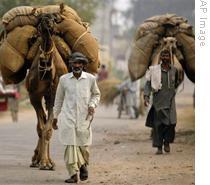VOA慢速英语 2009 0113a
搜索关注在线英语听力室公众号:tingroom,领取免费英语资料大礼包。
(单词翻译)
This is the VOA Special English Agriculture Report. |
| Farmers with their camels near Jammu, India, last year |
India had more than one million camels during the middle of the nineteen nineties. But the population of the animals known for their ability to travel far without much water has fallen sharply1. A group in Rajasthan state says India had only six hundred thousand camels by two thousand five. Rajasthan has traditionally been the area of the country with the most camels.
Experts say there are different reasons for the decrease. India's camels have lost the use of some traditional grasslands2 and forests because of development and climate change. Courts have barred camels from grazing3 in national parks. This makes it harder for their owners to feed them.
But animal doctor Pradeep Singhal blames the decrease in camels mainly on the influence of the outside world. The veterinarian says trucks and other modern vehicles are taking the place of camels.
Camels have served as an important form of transportation since ancient times. They are known as "ships of the desert." They carry goods and people, and they provide products including milk, skin, hair and bone. Some Indians eat camel meat. And farmers can use camel waste to fertilize4 their crops.
But fewer camels than in the past were traded at a recent camel fair in Pushkar, in Rajasthan. A strong camel can cost about one thousand dollars. A group called the League of Pastoral Peoples says fifty thousand camels were brought to the fair in two thousand four. This year, there were seventeen thousand five hundred camels, horses and other animals at the event.
Still, visitors could watch camel races and a contest to choose the most beautiful camel. The animals are washed and decorated with bells and jewelry5.
Doctor Singhal works6 with a volunteer organization based in Jaipur, Rajasthan, that helps people take care of their camels. The group is called Help in Suffering. This charitable trust works for the benefit of the animals of India. The group operates animal shelters. And it has been developing a specialized7 camel rescue center, which it describes as the first of its kind in India.
A camel weighs as much as eight hundred kilograms. Ten to fifteen people are needed to lift a sick or injured camel onto a truck. But the group has a new ambulance with devices8 for lifting a camel to drive it to an animal hospital.
And that's the VOA Special English Agriculture Report, written by Jerilyn Watson. Archives of our reports are at voaspecialenglish.com. I’m Bob Doughty9.
 收听单词发音
收听单词发音 




